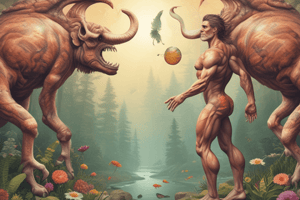Podcast
Questions and Answers
Which observation would challenge the concept of 'Inheritance of Acquired Characteristics' as proposed by Lamarck?
Which observation would challenge the concept of 'Inheritance of Acquired Characteristics' as proposed by Lamarck?
- Giraffes in the same population exhibit different neck lengths, with longer necks providing access to higher foliage.
- A child of a concert pianist is able to play advanced pieces at a very young age.
- A weightlifter's child is born with larger-than-average muscles.
- A plant grown in nutrient-poor soil produces smaller leaves, and its seeds yield plants with similarly small leaves even in rich soil. (correct)
A population of birds colonizes a new island. Initially, the birds all eat seeds. However, some birds have slightly larger beaks, allowing them to crack tougher seeds that are more abundant on the island. Over several generations, the average beak size in the population increases. Which of the following best explains this change in beak size?
A population of birds colonizes a new island. Initially, the birds all eat seeds. However, some birds have slightly larger beaks, allowing them to crack tougher seeds that are more abundant on the island. Over several generations, the average beak size in the population increases. Which of the following best explains this change in beak size?
- The birds with smaller beaks learn to crack the tougher seeds by stretching their beaks, and this acquired trait is passed on to their offspring.
- Birds with the largest beaks are able to find mates before other birds, allowing them more opportunities to pass on their genes.
- The environment on the island directly causes the birds' beaks to grow larger in response to the availability of tougher seeds.
- Birds with larger beaks have a higher survival and reproduction rate because they can access more food, leading to a higher frequency of these traits in the population. (correct)
A scientist is studying two closely related species of frogs that live in the same forest. One species breeds in fast-moving streams, while the other breeds in ponds. What type of adaptation is exemplified by this difference in breeding habitat?
A scientist is studying two closely related species of frogs that live in the same forest. One species breeds in fast-moving streams, while the other breeds in ponds. What type of adaptation is exemplified by this difference in breeding habitat?
- A behavioral adaptation, as the frogs exhibit different mating rituals. (correct)
- A physiological adaptation, as the frogs' body chemistry is suited to the different water types.
- A temporal adaptation, as the frogs breed at different times of the year.
- A structural adaptation, as the frogs have different leg muscle structures for swimming in different water types.
Which of the following represents the correct order of classification from broadest to most specific?
Which of the following represents the correct order of classification from broadest to most specific?
A researcher uses a dichotomous key to identify an unfamiliar plant species. The key leads to the following steps:
- Leaves are compound... Go to step 2
- Leaflets have smooth edges...Go to step 3
- Flowers are yellow...Species A
What can be concluded about Species A based solely on the dichotomous key?
A researcher uses a dichotomous key to identify an unfamiliar plant species. The key leads to the following steps:
- Leaves are compound... Go to step 2
- Leaflets have smooth edges...Go to step 3
- Flowers are yellow...Species A What can be concluded about Species A based solely on the dichotomous key?
Flashcards
Natural Selection
Natural Selection
The process where organisms better adapted to their environment tend to survive and reproduce.
Adaptation
Adaptation
A trait with a current functional role in the life of an organism that is maintained and evolved by means of natural selection.
Variation
Variation
Differences in traits among individuals of a population.
Classification
Classification
Signup and view all the flashcards
Binomial Nomenclature
Binomial Nomenclature
Signup and view all the flashcards
Study Notes
- Modern Evolutionary Theory is supported by evidence such as biogeography and fossils
- Charles Darwin's Theory of Natural Selection explains how organisms evolve over time
- Adaptations can be physiological, behavioral, or structural, aiding survival
- Individuals within a population exhibit variation, which is essential for evolution
- Lamarck's idea of Inheritance of Acquired Characteristics is an outdated theory
- Classification organizes living things into Domain, Kingdom, Phylum, Class, Order, Family, Genus, Species
- Binomial nomenclature provides each species with a unique two-part name
- Dichotomous keys are tools used to identify organisms based on contrasting characteristics
- Artificial selection involves humans selectively breeding organisms for desired traits
Studying That Suits You
Use AI to generate personalized quizzes and flashcards to suit your learning preferences.
Description
Explore modern evolutionary theory supported by biogeography and fossils. Learn about Darwin's theory of natural selection, adaptations, and population variation. Understand classification systems and binomial nomenclature.




